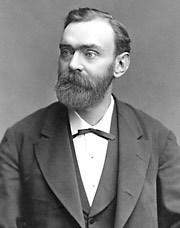
Alfred Nobel.
[Ed Note: Immersed as we are in the sheer volume and diversity of the Ava Helen and Linus Pauling Papers, it is sometimes easy for us as a staff to overlook the fact that Linus Pauling remains the only person to have received two unshared Nobel Prizes. As we begin our ninth year of blogging, we’ll be addressing Pauling’s extraordinary accomplishment with a six-part series. The first three parts will focus on the history and mechanics of the Nobel Prize, and the story of Pauling’s receipt of his two prizes in 1954 and 1963. The latter three parts will discuss those individuals who nominated Pauling for his awards, data that has recently made available by the Nobel Foundation.]
Linus Pauling is the only person who has received two unshared Nobel Prizes, one in Chemistry (1954) and another for Peace (1962, awarded in 1963). Two other individuals have won two Nobels, but they shared the prizes. These two additional double laureates are Marie Curie (also the first woman to win a Nobel Prize) and Frederick Sanger.
Alfred Nobel was a Swedish chemist, engineer, industrialist, and businessman who developed a safe way to detonate dynamite. One of his primary strengths was his ability to combine the imaginative and explorative mind of the scientist and inventor with the forward thinking of the industrialist. Nobel was also very interested in social and peace-related issues, and held what many considered to be radical views in his era. He likewise maintained a great interest in literature and wrote his own poetry and dramatic works.
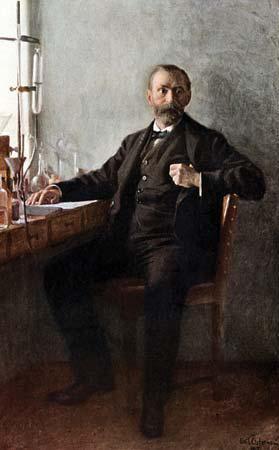
Portrait of Alfred Nobel by Emil Österman, 1915
Before he died, Nobel decided that the great wealth that he had accumulated over a lifetime of work should be used to endow “prizes to those who, during the preceding year, shall have conferred the greatest benefit to mankind.” The Nobel Prizes thus became an extension and a fulfillment of his life-long interests. After many years spent traveling and establishing laboratories in twenty different countries, Alfred Nobel died in San Remo, Italy, on December 10, 1896. He was sixty-three years old.
When Nobel’s will was unsealed, it came as a surprise to many that his fortune – equivalent to $265 million in 2015 dollars – was to be used to endow prizes honoring high achievement in the arts, sciences, and peace activism. In his last will and testament, he wrote that his estate:
shall constitute a fund, the interest on which shall be annually distributed in the form of prizes to those who, during the preceding year, shall have conferred the greatest benefit to mankind…which shall be apportioned as follows: one part to the person who shall have made the most important discovery or invention within the field of physics; one part to the person who shall have made the most important chemical discovery or improvement; one part to the person who shall have made the most important discovery within the domain of physiology or medicine; one part to the person who shall have produced in the field of literature the most outstanding work in an ideal direction; and one part to the person who shall have done the most or the best work for fraternity between nations, for the abolition or reduction of standing armies and for the holding and promotion of peace congresses.
He further directed that
The prizes for physics and chemistry shall be awarded by the Swedish Academy of Sciences; that for physiology or medical works by the Karolinska Institute in Stockholm; that for literature by the Academy in Stockholm; and that for champions of peace by a committee of five persons to be elected by the Norwegian Storting. It is my express wish that in awarding the prizes, no consideration be given to the nationality of the candidates, but that the most worthy shall receive the prize, whether he be Scandinavian or not.
The executors of Nobel’s will were two young engineers, Ragnar Sohlman and Rudolf Lilljequist. The duo set about forming the Nobel Foundation as an organization to take care of the financial assets left by Nobel for the purposes that he had stipulated, and to coordinate the work of the prize-awarding bodies. This process was not without its difficulties, especially since the will was contested by Nobel’s relatives and questioned by authorities in various countries.
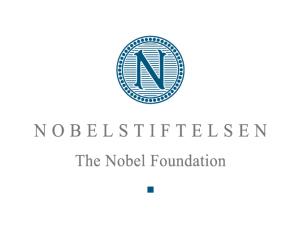
The main task of the Nobel Foundation is to safeguard the financial base of the Nobel Prizes, and to administer the work connected to the selection of the Nobel Laureates.
The nomination process is slightly different for each prize, due to the different institutions and hosting countries involved. In September or October of the year prior to a prize being awarded, nomination forms are sent out to qualified people to complete confidentially. Approximately 3,000 people are invited to nominate each year in chemistry; the quantity of nominators varies for the other subject areas. The requirements for a qualified nominator also vary between awards, but in the case of the chemistry prize they include:
- Swedish and foreign members of the Royal Swedish Academy of Sciences.
- Members of the Nobel Committee for Chemistry and Physics.
- Previous Nobel Laureates in Chemistry or Physics.
- Permanent professors in Chemistry at universities and institutes of technology in Sweden, Denmark, Finland, Iceland, Norway, and the Karolinska Institute in Stockholm.
- Chair holders at six selected universities or colleges selected by the Academy of Science, which together ensure an adequate distribution of perspectives over different countries and centers of learning.
The Academy may also invite nominations from other scientists whom they see fit to submit names.
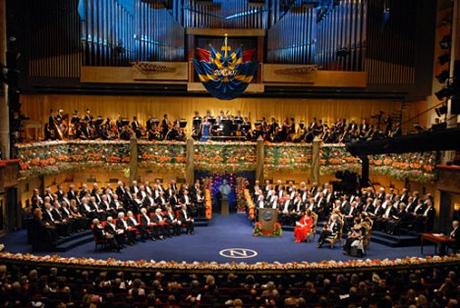
The Nobel Prize Award Ceremony in Stockholm, Sweden, 2007 Nobel Foundation image. Photo: Hans Mehlin
Nominations for the chemistry prize are returned to the Royal Swedish Academy of Sciences, where the five members of the Nobel Committee for Chemistry consult with a collection of experts to vet the names that they have received. The pool of names under consideration often number between 250-300 individuals, due to multiple nominators submitting the same names.
After consulting with experts from March through May, the committee then puts together a report by the end of August. After the report is completed, the committee submits its recommendations for the prize to the Swedish Academy in September. These recommendations are discussed by members of the Chemistry Section of the Academy at two meetings. Nobel laureates are then chosen in early October through a majority vote. This vote is final and without appeal, and the winner is then announced. The Nobel laureates receive their prizes on December 10 at the Stockholm Concert Hall. The prize consists of a Nobel medal and diploma, as well as a document insuring the cash award associated with the prize.
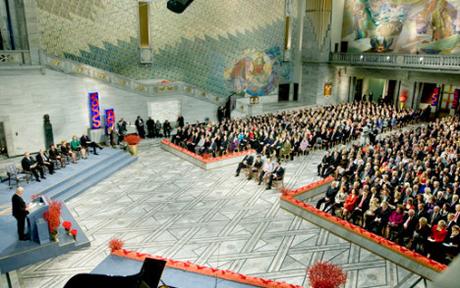
The Nobel Peace Prize Ceremony, 2008. Nobel Foundation image. Photo: Odd-Steinar Tøllefsen
The Nobel Peace Prize varies slightly in its nomination process. For one, the Norwegian Nobel Committee is responsible for Nobel Peace Prize selection. For another, a letter of invitation to nominate is not required and the qualifications of a nominator also differ. Nominators must be one of the following:
- Members of national assemblies and governments of states.
- Members of international courts.
- University rectors; professors of social sciences, history, philosophy, law, or theology; directors of peace research institutes and foreign policy institutes.
- Persons who have been awarded the Nobel Prize in Peace.
- Board members of organizations that have been awarded the Nobel Peace Prize.
- Active and former members of the Norwegian Nobel Committee.
- Former advisers to the Norwegian Nobel Committee.
For the Peace prize, there is no standardized form for nominations due to an understanding of the many ways that a nominee’s qualities can be described. However, nominations must include the name of the candidate; an explanation as to why the person or organization is deemed worthy of the Nobel Peace Prize; and the name, title, and professional affiliation of the nominator.
After receiving the nominations submitted before February 1, the Norwegian Nobel Committee prepares a short list of names by assessing the nominations’ validity and the candidates’ work. Nominations received after February 1 are included in the pool for the following year.
At its first meeting, the Peace Prize committee’s permanent secretary presents the list of candidates, which can be reviewed and added to. After this, the nomination process is considered closed, and the short list is prepared. Through August, advisers review the short list, which usually consists of twenty to thirty names, and create reports detailing their evaluation of the candidates under consideration. Advisers can include Norwegian university professors maintaining broad and varied expertise in relevant subject areas. When necessary, reports are also requested from other Norwegian and foreign experts. The Nobel Committee examines these reports in order to determine the most appropriate candidate and decides if any more information is needed.
In another difference from the Chemistry prize, the Peace Prize decision strives to be unanimous and is determined at the final meeting of the committee, held in October just before the prizes are announced. Just as with chemistry, the Peace Prize laureate is chosen and announced in early October, with the decision being final and without appeal. Though the ceremony for the Peace Prize takes place at City Hall in Oslo, Norway, it too is held on the tenth of December, the date that all Nobel awards are presented. As with the chemistry laureates, recipients of the Peace Prize receive a medal and diploma, as well as a certificate confirming the prize amount. For both prizes, nomination information is made not available for until fifty years following a nomination.
